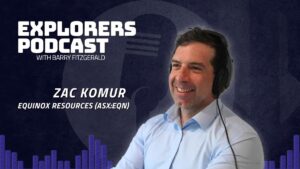This explorer believes the Pilbara will be an iron ore heartland for ‘a very, very long time to come’

Pic: John W Banagan/Stone via Getty Images.
The head of a new Pilbara explorer believes China will continue to value Australia’s iron ore despite claims it will look to become self-sufficient over the coming years.
Set amid diplomatic tensions between Australia and its biggest trading partner, it has long been suggested the Communist powerhouse will increase scrap steel imports, invest in domestic mines and finance projects in Africa to end its reliance on the ‘conveyor belt’ between WA’s northwest and the Chinese mainland.
But Equinox Resources (ASX:EQN) managing director Daniel Taylor, whose company owns the large Hamersley Iron project nestled between major mines owned by Rio Tinto (ASX:RIO) and Fortescue Metals Group (ASX:FMG), says it is still the best place in the world to develop a new iron ore mine.
“There’s two main iron ore provinces globally that have shown they can do it through thick and thin. And that’s really Australia and Brazil,” he said. “And yes, there is other jurisdictions being looked at, but I think they can carry a level of sovereign risk.
“And I think that the Pilbara will certainly be a very, very large, significant part of iron ore and supply to the steel industry for a very, very long time to come.
“And if it was my capital, I’d much rather it was invested in the Pilbara than in some of the more exotic provinces of the world.”
Pilbara miners deliver on low risk
Of the 1.5Bt of iron ore on the seaborne market, Australia produces around 900Mt – most of it from the Pilbara.
The trading relationship between customers in China and BHP and Rio Tinto, suppliers of 40% of all iron ore ocean freight, effectively sets prices for standard 62% iron ore fines, the main product consumed in Asia’s steel mills.
Taylor, an iron ore marketing executive for Atlas Iron, Anglo American and Gina Rinehart’s Roy Hill mine ahead of its construction, said while no one should doubt China’s ability to find new ways of doing business, projects in locations like Africa introduced significant risk into what is currently a simple and streamlined trade arrangement.
“I just think that people need to be aware of the level of risk attached to those projects,” he told Stockhead
“And the Pilbara is a low risk jurisdiction in that regard. It’s been done, all of the majors are there doing a lot of work on their sustaining tonnages going forward.
“It’s well understood. It’s the major capesize freight route in the world.
“We enjoy an ocean freight advantage, obviously over the Brazilian ores. But that said, the Australian ores are actually complementary to that which comes out of Brazil in a number of a number of ways.”
Steel market remains strong despite the dip
To some extent Equinox surprised on its debut last week, gaining more than 30% after its $9 million IPO.
It came as sentiment towards iron ore was waning, with prices dropping from more than US$230/t in May to US$125/t last week, having sagged to as low as US$93/t in September on the back of steel production cuts mandated by the Chinese Government.
While those environmentally-based restrictions will be maintained until the end of the year, it remains to be seen what Xi Jinping’s government will request next year.
To Taylor, the steel market remains incredibly strong despite the recent dip, with China’s factories still on track to deliver 1Bt of steel into the global market for only the second time after producing 1.05Bt last year.
That is almost 60% of global output, making China the market that matters when it comes to price, something that leaves Australia’s most valuable commodity and our economy as a whole exposed to the whims of China’s autocratic government.
“Obviously, the correction in prices that we’ve seen this year need to be put into a little bit of context,” Taylor said.
“If you look at say, 2020, China, broadly, 1 billion tons of crude steel production. In 2021, the year we’re still in, China is running or was running well ahead of the 1 billion tonnes a year.
“So they’re still gonna do a billion tons of steel production this year, despite the cuts … (that) were implemented in somewhat of a haphazard manner.
“if we look purely at steel production, you say, ‘what’s actually changed?’ And the answer is nothing.
“So in terms of Chinese demand, at a macro level year on year, you’re not seeing dramatic moves.
“We’re not talking about an iron ore environment where the price has gone from US$230-odd a tonne and Chinese steel production in 2022 is only going to be 800 million tons. (If that was the case) then we would be seeing a fundamental change in the market and the dynamics there.”
Could there ever be another Fortescue or Roy Hill?
It is worth noting that it was not all that long ago US$45 billion Fortescue, the third force in iron ore which now exports 180Mt of Pilbara dirt every year, was a junior explorer.
While the conditions that enabled FMG to grow were specific to a particular place, time and regulatory environment, Taylor said there are still opportunities for new miners to emerge.
He said there remain new deposits to be exploited as port and logistics options open up.
While we have seen a number of small-scale high cost junior miners open and close operations amid a volatile market this year characterised by wild price movements and unprecedentedly high freight costs, Equinox’s focus is on proving up the quality of its own projects rather than the market.
The company listed to roll the Hamersley Iron project out of Pathfinder Resources (ASX:PF1) and Cazaly Resources (ASX:CAZ) – who won around 36% and 15% of Equinox’s stock, respectively – into a single pure play iron ore explorer.
Located 50km northeast of Tom Price on a granted mining lease immediately south of FMG’s Solomon Hub, the project contains a total inferred and indicated resource of 343.2Mt at 54.5% iron content.
Equinox’s plan post-IPO is to drill out the resource and collect customer and metallurgical samples to identify the best processing and logistics options and product to take to market.
“We’ve got the large resource that sits there, but the focus for us is really on drilling, further drilling,” Taylor said.
“And that is driven not so much by increasing the size of the resource, it’s about increasing our understanding of the resource and looking at the opportunities for near term development.
“We’re not there to grow from where we are, with our resource base, to 400-500 million tonnes.
“The focus is on doing the work around the metallurgy, which will also allow us to do further work both with customer markets in terms of the ultimate end users, but also in terms of the operational aspects in terms of processing.”
Equinox Resources share price today:
UNLOCK INSIGHTS
Discover the untold stories of emerging ASX stocks.
Daily news and expert analysis, it's free to subscribe.
By proceeding, you confirm you understand that we handle personal information in accordance with our Privacy Policy.








